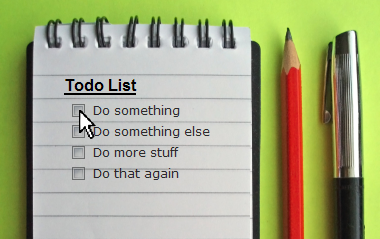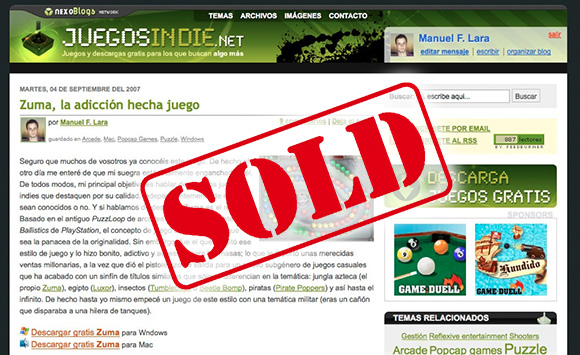Since I quit my job 4 years ago to work on my own, I’ve been working from home. Here are some of the things I’ve learned along the way that help me be productive and happy.

Find your sweet spot
Some people recommend having a home office, others going to coffee shops and there’s also people who like coworking spaces. I’ve tried them all (and so should you), and I prefer having a home office. If I don’t have space for a proper office, then at least a good desk, comfy chair and big monitor. Failing that (this happens a lot when travelling), a desk that can fit my laptop and mousepad, and a chair that isn’t crap will do. While travelling, I’ve been surprised at how little I need to be productive. There are a few things I can’t compromise on, though, if I want to really be productive, which leads me to my next point.
Get rid of productivity killers
We all have certain things that totally kill our productivity. Get rid of them. For me, a temperature outside of a certain range, is a productivity killer. If it’s too hot or humid (again, this happens sometimes when travelling), I can’t get anything done. If it’s too cold, the same thing happens, but this is rare where I usually choose to live.
Other productivity killers of mine:
- Using a trackpad instead of a mouse. I can get some work done with a trackpad, but less.
- Having a crappy chair or desk (i.e. being uncomfortable while sitting on my computer).
- Not having a list of things I need to work on (more on this later).
- Too much noise. I can deal with some noise, specially white noise. I don’t need total silence, but having people talking around me can distract me pretty easily. That’s one of the reasons I don’t like to work from coffee shops.
- Slow or unstable Internet. Nothing kills my productivity more effectively than having the Internet go down (not for all tasks, but for most).
- Interesting things happening around me. I always thought having fun and interesting coworkers was great, and it is, but it also kills my productivity if we’re sitting next to each other in an open space. I guess I don’t want to “miss out” on whatever’s going on.
- Other distractions: someone talking to me or buzzing the door (remember I work from home), phone calls and notifications (when working I always have my phone on “don’t disturb” mode), computer notifications (I close Facebook and Gmail tabs when I want to get shit done)…
- Bugs I can’t fix quickly. This is one of the most annoying ones. When I hit a roadblock with my programming (say, spend half an hour to an hour trying to get something simple to work), it kills my productivity rather quickly. It’s just not fun at all. And it’s always, ALWAYS, something stupid.
As you can see most of my productivity killers can be avoided with proper habits and planning. You should make a list of yours and also plan accordingly.
Respect the Zone
In case you don’t know what being in the zone is, here’s a description I found online:
Expression used to describe a state of consciousness where actual skills match the percieved performance requirements perfectly. Being in the zone implies increased focus and attention which allow for higher levels of performance. Athletes, musicians, and anybody that totally owns a challenge of physical and mental performance can be in the zone.
For people working on their own schedule and doing any kind of creative work, being in the zone is critical. It’s not like you need to be in the zone to get work done, but that when you are in the zone, you will effortlessly get shit done properly without even noticing it. So you should figure out what helps you get in the zone (step 1: get rid of your productivity killers) and also find a way to stay there for as long as you can (zero distractions or breaks).
Take breaks
There are people who advocate for the Pomodoro technique, which forces breaks on you every fixed amount of time (i.e. you need to take a break 5 minutes every hour). I find this can get you out of the zone pretty quickly, and I prefer to take breaks in between tasks. If a task takes me 15 minutes to do, I might take a 5 minute break afterwards. And if it takes 2 or 3 hours, I will probably not stop either until I’m done. Of course, there are always tasks that might take too many hours (or days!) to finish and you need to break them down into doable smaller subtasks. I don’t know about you but I personally hate leaving a task half done (if , for example, I need to go somewhere), so I prefer smaller tasks that I can finish before calling it a day.
Define what needs to be done
Once I get down to work, I don’t want to have to think about what I need to work on. I should know that already. That’s why I plan at least one week in advance (usually two) worth of tasks in advance. On the weekend, I sit down and review my tasks for the week: are they doable? too many? too few? is there anything that I can anticipate may stop me from doing those tasks (if so, take care of that in advance or create other tasks to deal with it)? Then I create those tasks on Basecamp and arrange them on the calendar view (which is my favorite way of looking at my projects).
I also like having other not-work related (but still important) tasks visible at all times. Read more about my To-Do List setup.
Finish something every day
You should always finish the day having accomplished something. For example, replying to a thousand emails doesn’t count for me. I need to have “produced” or built something. At least one thing. Write a blog post, mock up a design, code a new feature, fix a bug… You need to be able to “check” some task off your list every day. I also use iDoneThis to write, at the end of the way, everything I did, and get that feeling of “I got work done today”.
On top of actually finishing something every day, I suggest you add some physical action to celebrate it. For example, if your to do list is on paper, crossing that task with a pen would be it. If you use an online tool, marking it as “done”. Or writing it in a “what I got done today” journal. You get the idea. Soon enough you’ll be hooked to that and you’ll be pushing yourself to get more things done just so you can get that rush of satisfaction again.
Take time off
For the longest time, I wouldn’t take a single day off. Or if I did (either because I wanted to or because I was too burnt out to work), I felt guilty. Now I understand that weekends serve a very important purpose. They allow us to unwind and recharge batteries to start the following week with all the intensity that our work deserves.
Also, take holidays, not just weekends off. It’s easier to believe that you need to be on top of things 24/7 in order for your company to run properly. That everything would explode if you took a week or two off. Turns out it doesn’t. You will have a longer list of unread emails when you come back, but that’s it.
Last week I was in Bali and we rented an amazing villa for the weekend (the rest of the month we were staying in a nice, but not super nice, house). We decided to stay an extra 2 days until we had to leave Bali. And then we had a day of moving, flying, etc (spoiler: you won’t get anything done on those days). I decided to take that week off, on the spot. I had a bunch of tasks I wanted to get done that week. Important stuff. But I knew they could wait, and I also knew I wanted to take that week off, and that I hadn’t taken a proper holiday in months. This is why I didn’t publish anything last week, by the way 🙂
Actually disconnect on your time off
I know this is easier said than done (been there), but you can’t be constantly checking your email or thinking about work when you’re on your time off. It will make you feel guilty for not being working, not present in the moment (which means you’ll enjoy less whatever it is you’re doing) and overall, a less happy person. If you come across a brilliant thought, send yourself an email and forget about it.
If you happen to run a business and you also do the customer support for it, I understand the desire to be available and reply quickly 24/7. I’ve been there. Outsource it. Trust me, it’s the best decision you’ll ever make. Yes, they may not reply 100% as quickly and with as much passion as you do, but you’ll be a much happier person and that will reflect in all aspects of your life.
Outsource as much as possible
Technically, everything is outsourceable, but I don’t think you should outsource everything. Things that you do repeatedly, that are easy to teach, and that don’t make you happy? Outsource those as soon as possible. Depending on what you do for a living, the list can be very different. Also, some tasks are easier to oursource than others (for example, I’ve found that outsourcing any kind of development work is just not worth it unless you’re willing to pay top dollar or you don’t care much about the quality of the work produced).
These are the things I successfully outsource: customer support, community management, logo design, system administration, content creation, data entry and research. Yes, I also do some of those myself depending on the situation, but only when I want to, or personally doing it would be much, much better for the business than outsourcing it (it’s fewer times than you think).
Work smart, not hard
When I hear about all those Silicon Valley startup founders who claim to work over 80 hours a week, I don’t know if they lie, count “not really work but kind of” stuff as work (say, reading TechCrunch or commuting), overestimate the amount of time they actually work because they don’t track it (I do), or are just a superior race. Me? I rarely crack the 6 hour of productive time per day. And by productive time, I mean it. I use Freckle to track the time I spend working every day, and I stop the timer every time I’m not actually working. So when I’m reading TechCrunch, going to the bathroom, making a (non work related) phone call, going for a glass of water, etc. the timer is stopped. Start tracking your time this way, and you’ll be surprised how much time you think you work but you actually don’t.
Also, when you work for yourself (this doesn’t apply if you are working remotely for someone else), a big part of working smart is deciding what to work on. There’s always an unlimited amount of things fighting for your attention. Every time I look at the backlog of “pending features” for my company I want to laugh or cry, depending on my mood. Bottom line is, there’s always going to be more work to be done, it’s never going to stop. So don’t kill yourself by trying to do too much of it. Pick the right things to work on: high impact, easy to implement. Came up with a high impact, hard to implement task? Rethink it and come up with another task that gives 80% of the benefits for 20% of the work.
 Reading a post on
Reading a post on  Like most developers, I have a problem when it comes to pricing my products and services. I feel like people will think I’m ripping them off or that the price isn’t justified given the value it provides. Basically, I always feel I’m overcharging. Even when it’s clear people would pay for my product (sometimes I even wonder wether I should charge at all!), I have a hard time coming up with a price tag.
Like most developers, I have a problem when it comes to pricing my products and services. I feel like people will think I’m ripping them off or that the price isn’t justified given the value it provides. Basically, I always feel I’m overcharging. Even when it’s clear people would pay for my product (sometimes I even wonder wether I should charge at all!), I have a hard time coming up with a price tag. When
When 
 I’ve tried a lot of task management systems and to-do list apps over the years. Simple and complex, web-based and native, mobile and desktop. Despite some of them being quite slick, I always ended up ignoring them over time. It seems stupid, but just the fact that my tasks are on some separate app that I have to consciously open and keep updated, makes me drop them eventually. It is “too much work”. Eventually I found a workflow that’s so integrated into my daily routine that it works perfectly for me. Everyone’s different, but I’m sure some people will find it works wonderfully for them too.
I’ve tried a lot of task management systems and to-do list apps over the years. Simple and complex, web-based and native, mobile and desktop. Despite some of them being quite slick, I always ended up ignoring them over time. It seems stupid, but just the fact that my tasks are on some separate app that I have to consciously open and keep updated, makes me drop them eventually. It is “too much work”. Eventually I found a workflow that’s so integrated into my daily routine that it works perfectly for me. Everyone’s different, but I’m sure some people will find it works wonderfully for them too.
 We finally put the website for the
We finally put the website for the 